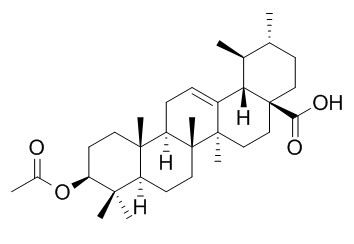Acetylursolic acid
Acetylursolic acid shows significant cytotoxic activities, and shows suppression of the SOS-inducing activity of mutagenic heterocyclic amine, Trp-P-1. 3β-Acetylursolic acid can reduce parasitaemia against Plasmodium berghei.
Inquire / Order:
manager@chemfaces.com
Technical Inquiries:
service@chemfaces.com
Tel:
+86-27-84237783
Fax:
+86-27-84254680
Address:
1 Building, No. 83, CheCheng Rd., Wuhan Economic and Technological Development Zone, Wuhan, Hubei 430056, PRC
Providing storage is as stated on the product vial and the vial is kept tightly sealed, the product can be stored for up to
24 months(2-8C).
Wherever possible, you should prepare and use solutions on the same day. However, if you need to make up stock solutions in advance, we recommend that you store the solution as aliquots in tightly sealed vials at -20C. Generally, these will be useable for up to two weeks. Before use, and prior to opening the vial we recommend that you allow your product to equilibrate to room temperature for at least 1 hour.
Need more advice on solubility, usage and handling? Please email to: service@chemfaces.com
The packaging of the product may have turned upside down during transportation, resulting in the natural compounds adhering to the neck or cap of the vial. take the vial out of its packaging and gently shake to let the compounds fall to the bottom of the vial. for liquid products, centrifuge at 200-500 RPM to gather the liquid at the bottom of the vial. try to avoid loss or contamination during handling.
J. Pharm. Biomed. Anal.2024, 245:116193.
J. Food Composition and Anal.2022, V 109:104482.
J Hematol Oncol.2018, 11(1):112
Biochem Biophys Res Commun.2019, 518(4):732-738
Int J Mol Sci.2019, 20(8):E1855
Biomed Pharmacother.2022, 145:112410.
Foods.2022, 11(6):882.
New Zealand J. Forestry Sci.2014, 44:17
J Food Sci.2021, 86(9):3810-3823.
Biol Pharm Bull.2018, 41(11):1645-1651
Related and Featured Products
Phytochemistry. 2005 Feb;66(4):495-501.
Cytotoxic triterpenes from the aerial roots of Ficus microcarpa.[Pubmed:
15694457 ]
METHODS AND RESULTS:
Six triterpenes, 3beta-acetoxy-12,19-dioxo-13(18)-oleanene (1), 3beta-acetoxy-19(29)-taraxasten-20alpha-ol (2), 3beta-acetoxy-21alpha,22alpha-epoxytaraxastan-20alpha-ol (3), 3,22-dioxo-20-taraxastene (4), 3beta-acetoxy-11alpha,12alpha-epoxy-16-oxo-14-taraxerene (5), 3beta-acetoxy-25-methoxylanosta-8,23-diene (6) along with nine known triterpenes, 3beta-acetoxy-11alpha,12alpha-epoxy-14-taraxerene (7), 3beta-acetoxy-25-hydroxylanosta-8,23-diene (8), oleanonic acid (9), acetylbetulinic acid (10), betulonic acid (11), Acetylursolic acid (12), ursonic acid (13), ursolic acid (14), and 3-oxofriedelan-28-oic acid (15) were isolated from the aerial roots of Ficus microcarpa, and their structures elucidated by spectroscopic methods. The in vitro cytotoxic efficacy of these triterpenes was investigated using three human cancer cell lines, namely, HONE-1 nasopharyngeal carcinoma, KB oral epidermoid carcinoma, and HT29 colorectal carcinoma cells.
CONCLUSIONS:
Compound 8 and pentacyclic triterpenes 9-15 possessing a carboxylic acid functionality at C-28 showed significant cytotoxic activities against the aforementioned cell lines and gave IC50 values in the range 4.0-9.4 microM.
J Agric Food Chem. 2005 Mar 23;53(6):2312-5.
Suppression of the SOS-inducing activity of mutagenic heterocyclic amine, Trp-P-1, by triterpenoid from Uncaria sinensis in the Salmonella typhimurium TA1535/pSK1002 Umu test.[Pubmed:
15769173 ]
METHODS AND RESULTS:
The methanol extract from Uncaria sinensis showed a suppressive effect on umu gene expression of the SOS response in Salmonella typhimurium TA1535/pSK1002 against the mutagen 3-amino-1,4-dimethyl-5H-pyrido[4,3b]indole (Trp-P-1), which requires liver metabolizing enzymes. The methanol extract from U. sinensis was re-extracted with hexane, CH2Cl2, BuOH, and water, respectively. CH2Cl2 extract showed a suppressive effect. A suppressive compound 1 in CH2Cl2 extract was isolated by SiO2 column chromatography. Compound 1 was identified as ursolic acid by IR, electron ionization EI-MS, and NMR spectroscopy. Suppressive effects of ursolic acid (1) and its derivatives, methyl ursolate (1M), Acetylursolic acid (1A), and methyl acetylursolate (1MA), were determined in the umu test.
CONCLUSIONS:
These compounds suppressed 61.3, 37.7, 71.5, and 37.8% of the Trp-P-1-induced SOS response at a concentration of 0.4 micromol/mL, respectively. The ID50 values of compounds 1 and 1A were 0.17 and 0.20 micromol/mL. In addition, these compounds were assayed with the activated Trp-P-1. Suppressive effects on activated Trp-P-1 were decreased as compared with those of Trp-P-1.
Molecules. 2013 Oct 8;18(10):12313-23.
Anti-plasmodial activity of some Zulu medicinal plants and of some triterpenes isolated from them.[Pubmed:
24108397 ]
Mimusops caffra E. Mey. ex A.DC and Mimusops obtusifolia Lam (both members of the Sapotaceae family), and Hypoxis colchicifolia Bak (family Hypoxidaceae) are used by traditional healers in Zululand to manage malaria.
METHODS AND RESULTS:
Anti-plasmodial investigation of the crude extracts and some triterpenes isolated from the plants showed activity against a chloroquine sensitive (CQS) strain of Plasmodium falciparum (D10). Among the crude extracts the leaves of M. caffra exhibited the highest activity, with an IC₅₀ of 2.14 μg/mL. The pentacyclic tritepenoid ursolic acid (1), isolated from the leaves of M. caffra was the most active compound (IC₅₀ 6.8 μg/mL) as compared to taraxerol (2) and sawamilletin (3) isolated from the stem bark of M. obtusifolia (IC₅₀ > 100). Chemical modification of the ursolic acid (1) to 3β-Acetylursolic acid (4) greatly enhanced its anti-plasmodial activity. Compound 4 reduced parasitaemia against Plasmodium berghei by 94.01% in in vivo studies in mice.
CONCLUSIONS:
The cytotoxicity of 3β-Acetylursolic acid (IC₅₀) to two human cell lines (HEK293 and HepG2) was 366.00 μg/mL and 566.09 μg/mL, respectively. The results validate the use of these plants in folk medicine.
Tetrahedron.1994 Feb21; 50(8):2591–2598.
Oxidative decarboxylation by hydrogen peroxide and a mercury (II) salt: A simple route to nor-derivatives of acetyloleanolic, acetylursolic and dehydroabietic acids.[Reference:
WebLink]
Treatment of carboxylic acids with hydrogen peroxide in the presence of a mercury (II) salts results in oxidative decarboxylation and is an effective method for transformation of the carboxylic acids into the corresponding nor-derivatives, hydroperoxides and alcohols. Oxidative decarboxylation of acetyloleanolic acid, Acetylursolic acid and dehydroabietic acid is described.



